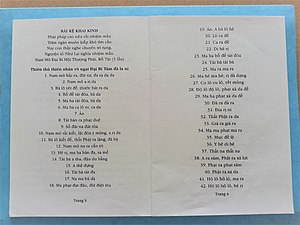Buddhism in Vietnam
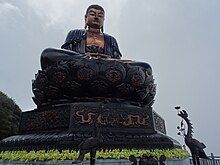
Buddhism in Vietnam(Vietnamese:Đạo Phật,Nói Phật orPhật Giáo,Phật giáo ), as practiced by theVietnamese people,is a form ofEast AsianMahayana Buddhism.It is the main religion inVietnam.Vietnamese Buddhism is generally inclusive and syncretic, drawing on the mainChinese Buddhist traditions,such asTiantai(Vietnamese: Thiên Thai) andHuayan(Hoa Nghiêm),Zen(Thiền), andPure Land(Tịnh Độ).[1][2][3]
Buddhismmay have first come toVietnamas early as the 3rd or 2nd century BCE from theIndian subcontinentor fromChinain the 1st or 2nd century CE.[4]Vietnamese Buddhism has had asyncreticrelationship with certain elements ofTaoism,Chinese spirituality,andVietnamese folk religion.[5]Theravada Buddhismalso exists, as well as indigenous forms of Vietnamese Buddhism such asBửu Sơn Kỳ HươngandHòa Hảo.
History
[edit]

| Part ofa serieson |
| Buddhism |
|---|
 |
Dynastic period
[edit]There are conflicting theories regarding whether Buddhism first reached Vietnam during the 3rd or 2nd century BCE via delegations from India, or during the 1st or 2nd century from China.[6]In either case, by the end of the 2nd century CE, Vietnam had developed into a major regional Mahayana Buddhist hub, centering onLuy Lâuin modernBắc Ninh Province,northeast of the present-day capital city ofHanoi.Luy Lâu was the capital of the Han region ofJiaozhiand was a popular destination visited by many Indian Buddhist missionary monks en route to China. The monks followed the maritime trade route from the Indian subcontinent to China used by Indian traders. A number ofMahayana sutrasand theāgamaswere translated intoClassical Chinesethere, including theSutra of Forty-two Chaptersand theAnapanasmrti-sutra.
Jiaozhiwas the birthplace of Buddhist missionaryKang Senghui,who was ofSogdianorigin.[7][8]
Over the next eighteen centuries, Vietnam and China shared many common features of cultural, philosophical and religious heritage as a result of geographical proximity and Vietnam being annexed twice by China. Vietnamese Buddhism is thus related toChinese Buddhismin general, and to some extent reflects the formation of Chinese Buddhism after theSong dynasty.[3]Meanwhile, in 875 new Cham kingIndravarman IIwho was a devout Mahayana Buddhist, established Mahayana asChampa'sstate religion, and built the large monastery complex ofĐồng Dương.His dynasty continued to rule Champa until the late 10th century.[9]
During theĐinh dynasty(968–980), Mahayana Buddhism was recognized by the state as an official religion (~971), reflecting the high esteem of Buddhist faith held by the Vietnamese monarchs, included some influences from theVajrayanasection.[10]TheEarly Lê dynasty(980–1009) also afforded the same recognition to the Buddhist sangha. The growth of Buddhism during this time is attributed to the recruitment of erudite monks to the court as the newly independent state needed an ideological basis on which to build a country. Subsequently, this role was ceded to Confucianism.[11]

Vietnamese Buddhism reached its zenith during theLý dynasty(1009–1225), beginning with the founderLý Thái Tổ,who was raised in aBuddhist temple.[12]All of the emperors during the Lý dynasty professed and sanctioned Buddhism as the state religion. This endured with theTrần dynasty(1225–1400), but Buddhism had to share the stage with the emerging growth ofConfucianism.

By the 15th century, Buddhism fell out of favor with the court during the Later Lê dynasty, although still popular with the masses. Officials likeLê Quátattacked it as heretical and wasteful.[13]It was not until the 19th century that Buddhism regained some stature under theNguyễn dynasty,which accorded royal support.[14]
A Buddhist revival movement (Chấn hưng Phật giáo) emerged in the 1920s in an effort to reform and strengthen institutional Buddhism, which had lost grounds to the spread of Christianity and the growth of other faiths under French rule. The movement continued into the 1950s.[15]
Republican period
[edit]From 1954 to 1975, Vietnam was split intoNorthandSouth Vietnam.In a country where surveys of the religious composition estimated the Buddhist majority to be approximately 70 to 80 percent,[16][17][18][19][20][21][22]South Vietnamese PresidentNgô Đình Diệm's policies generated claims of religious bias. As a member of the Catholic Vietnamese minority, he pursued pro-Catholic policies that antagonized many Buddhists.

In May 1963, in the central city ofHuế,where Diệm's elder brotherNgô Đình Thụcwas the archbishop, Buddhists were prohibited from displaying Buddhist flags duringVesakcelebrations.[23]Yet few days earlier, Catholics were allowed to fly religious flags at a celebration in honour of the newly seatedarchbishop.This led to widespread protest against the government; troops were sent in, and nine civilians were killed in the confrontations. This led to mass rallies against Diệm's government, termed as theBuddhist crisis.The conflicts culminated inThích Quảng Đức's self-immolation by lighting himself on fire in protest of the persecution of Buddhists. President Diệm's younger brotherNgô Đình Nhufavored strong-armed tactics, andArmy of the Republic of Vietnam Special Forcesengaged in theXá Lợi Pagoda raids,killing estimated hundreds.[citation needed]Dismayed by the public outrage, the U.S. government withdrew support for the regime. President Diệm wasdeposed and killed in the 1963 coup.[24][25]
Political strength of the Buddhists grew in the 1960s as different schools and orders convene to form theUnified Buddhist Sangha of Vietnam.Leaders of theSanghalikeThích Trí Quanghad considerable sway in national politics, at times challenging the government.
With thefall of Saigonin 1975, the whole nation came underCommunistrule; many religious practices including Buddhism were discouraged. In the North, the government had created theUnited Buddhist Sangha of Vietnam,co-opting the clergy to function under government auspices, but in the South, theUnified Buddhist Sangha of Vietnamstill held sway and openly challenged the communist government. The Sangha leadership was thus arrested and imprisoned; Sangha properties were seized and the Sangha itself was outlawed. In its place was the newly createdBuddhist Sangha of Vietnam,designed as the final union of all Buddhist organizations, now under full state control.
Modern period
[edit]
The treatment of Buddhists started to ease sinceĐổi mớiin 1986.
SinceĐổi Mớiin 1986, many reforms have allowed Buddhists to practice their religion relatively unhindered. However, no organized sangha is allowed to function independent of the state. It was not until 2007 thatPure Land Buddhism,the most widespread type of Buddhism practiced in Vietnam, was officially recognized as a religion by the government.[26]Thích Quảng Độ,the Patriarch of the Unified Buddhist Sangha, once imprisoned, remained under surveillance and restricted in his travels until his death.
Today, Buddhists are found throughout Vietnam, from North to South. Buddhism is the single largest organized religion in Vietnam, with somewhere between 45% and 55% of the population identifying themselves as Buddhist.[27][28]Some argued that the number is higher than reported, as many declared themselves as atheists but still participate in Buddhist activities.
Though theCommunist Party of Vietnamofficially promotes atheism, it has usually leaned in favor of Buddhism, as Buddhism is associated with the long and deep history of Vietnam. Also, there have rarely been disputes between Buddhists and the Government;[29]the Communist Government also sees Buddhism as a symbol of Vietnamese patriotism. Buddhist festivals are officially promoted by the Government and restrictions are few,[30]in contrast to its Christian, Muslim and other religious counterparts.
Recently, the Communist regime in Vietnam allowed major Buddhist figures to enter the country.Thích Nhất Hạnh,an influential Buddhist figure revered both in Vietnam and worldwide, is among these.[31]Distancing itself from the fellow communist neighbor China, the Government of Vietnam allows the publishing of books and stories of14th Dalai Lama,who has a personal friendship with Thích Nhất Hạnh and were commonly critical of the Chinese regime after the2008 Tibetan unrest,[32]which was seen as an attempt to antagonize the Chinese Government and China as a whole, as Beijing still considers the Dalai Lama to be a terrorist.
TheVietnam Buddhist Sanghahas placed much emphasis on promoting Buddhism to remote areas and ethnic minorities beyond the nativeKinhpeople group, in contrary to other Buddhist governing body in the region. These efforts has given rise to more ethnic minorities embracing Buddhism in remote areas, especially in theCentral Highlandsregion of Vietnam.
For example, Buddhists adherent in theKon Tumprovince, a traditionally non-Buddhist region has grown to host 30,000 Buddhists since arriving in the 1930s, with 4,000 of them being of ethnic minority. There are 27 Pagodas and 6 Viharas in the region with 90 active Buddhist monastics today.[33]
Separately,Dak Lakprovince of Vietnam has also seen a rise in Buddhist adherent with about 3,000 adherents coming from ethnic minority such as theE Depeople group.[34]
Overseas
[edit]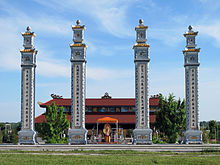
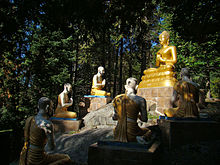
After the fall of South Vietnam to the Communist North in 1975 at the end of theVietnam War,the first major Buddhist community appeared in North America. Since this time, the North American Vietnamese Buddhist community has grown to some 160 temples and centers. Proselytizing is not a priority.
The most famous practitioner of synchronizedVietnamese Thiềnin the West isThích Nhất Hạnh,who has authored dozens of books and founded thePlum Village Monasteryin France together with his colleague,bhikṣuṇīand Zen MasterChân Không.According to Nguyen and Barber, Thích Nhất Hạnh's fame in the Western world as a proponent of engaged Buddhism and a new Thiền style has "no affinity with or any foundation in traditional Vietnamese Buddhist practices",[35]and according to Alexander Soucy (2007), his style of Zen Buddhism is not reflective of actual Vietnamese Buddhism. These claims are contradicted by Elise Anne DeVido, who examined the life and legacy of Thích Nhất Hạnh and how we can understand his teachings in terms of its Vietnamese origins.[36]Thích Nhất Hạnh also often recounts about his early Thiền practices in Vietnam in his Dharma talks, saying that he continued and developed this practice in the West, which has a distinctive Vietnamese Thiền flavor.[citation needed]
Thích Nhất Hạnh's Buddhist teachings have started to return to Vietnam, where the Buddhist landscape is now being shaped by the combined Vietnamese and Westernized Buddhism that is focused more on the meditative practices.[37]
Practice
[edit]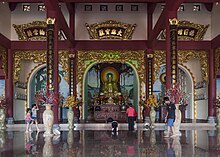

Followers in Vietnam practice differing traditions without any problem or sense of contradiction.[38]Few Vietnamese Buddhists would identify themselves as a particular kind of Buddhism, as a Christian might identify themself by a denomination, for example. Although Vietnamese Buddhism does not have a strong centralized structure, the practice is similar throughout the country at almost any temple.
Gaining merit is the most common and essential practice in Vietnamese Buddhism with a belief that liberation takes place with the help of Buddhas and bodhisattvas. Buddhist monks commonly chant sutras, recite Buddhas' names (particularlyAmitābha), doing repentance, and praying for rebirth in the Pure Land.[39]
TheLotus Sutraand theAmitabha Sutraare the most commonly used sutras.[39]Most sutras and texts are inVăn ngônand are merely recited withSino-Xenic pronunciations,making them incomprehensible to most practitioners.
Three services are practiced regularly at dawn, noon, and dusk. They include sutra reading withniệm Phậtanddhāraṇī,including theChú Đại Bi(theNīlakaṇṭha Dhāraṇī), recitation andkinh hành(walking meditation). Laypeople at times join the services at the temple, and some devout Buddhist practice the services at home. Special services such assám nguyện/sám hối(confession/repentance) takes place on thefull moonandnew mooneach month. The niệm Phật practice is one way of repenting and purifying bad karma.[38]
Buddhist temples also serve a significant role in death rituals and funerals amongoverseas Vietnamese.
The Chú Đại Bi
[edit]At the entrance of many pagodas, especially in tourist places, theChú Đại Bi(Vietnamese version of the Chinese Đại Bi ChúDàbēi zhòu,theNīlakaṇṭha Dhāraṇīor Great Compassion Dharani or Mantra), is made available to visitors, either printed on a single sheet in black and white, or as a color booklet on glossy paper. They are printed on the initiative of Buddhist practitioners who make an offering to thesangha.
•Left:Sheet of plain paper (21x29.7 cm). Complete text ofChú Đại Bi,ie 84 verses, printed in black and white. At the top of the page, on both sides, are the representations of Buddha A Di Đà (Amitābha) and Bodhisattva Quán Âm (Guanyin).
•Center:Two booklets, first covers, flexible cardboard (21x14.5 cm). -Green colored copy,32 p.:Quan Âm(or Quán Thế Âm Bồ Tát) is standing on a lotus. She is represented in her form with twenty-four arms and eleven faces: hers, the others symbolizing the ten directions of space (the fourcardinal directions,the fourintercardinal directions,thenadirand thezenith,that the Boddhisattva can observe simultaneously.)
The meaning (and not the literal translation) of the words "Nghi Thức Trì Tụng"is:"Instructions for reciting welltheChú Đại Bi".
•Right:An open booklet. We can read the numbered verses 1-42 of the "Chú Đại Bi", that is to say half of the full text.
Note:one of the booklets has more pages (32) than the other (12) because it is more illustrated and contains ritual instructions (as indicated on the front cover).
- Text
TheChú Đại Bi(Vietnamese translation of the Chinese title Đại Bi ChúDàbēi zhòu), is divided into 84 verses and available in either unnumbered or numbered versions. The text recited in religious services is atranscriptioninto modern Vietnamese (Chữ Quốc ngữ) from the ancient Vietnamese (Chữ NômandChữ Hán) text, which was itself a transcription from Chinese (not a traduction). The following translations into modern Vietnamese and English are based on the work of Vietnamese historian Lê Tự Hỷ[40]and Indian historianLokesh Chandra.[41]A reconstruction inSanskritIASTfrom the original text, by Lê Tự Hỷ, is also proposed.
| Chú Đại Bi 1 & 2. Transcription and traduction from ancient Vietnamese (Chữ NômandChữ Hán) to modern Vietnamese (Chữ Quốc ngữ) and translation in English. 3. Reconstructed text in Sanskrit IAST. |
*1. Text without the numbering of the verses[42]. The following text is thetranscriptioninto modern Vietnamese (chữ Quốc ngữ) from Old Vietnamese (Chữ NômandChữ Hán) version, itself a transliteration from the Chinese Đại Bi ChúDàbēi zhòu:
The following is a reconstruction of the text in SanskritIASTby the vietnamese historian Lê Tự Hỷ[40]who proposes a division into five parts, close to that ofLokesh Chandra.[52][53]It is divided into 18 grammatically structured sentences[54](one can notice that the terms "dhāraṇī"and"mantra"are used alternately).
|
Branches
[edit]Mahāyāna traditions
[edit]

The overall doctrinal position of Vietnamese Buddhism isinclusiveandsyncretic,adopting doctrines from Chinese Buddhist schools likeTiantai(Thiên Thai) andHuayan(Vietnamese:Hoa Nghiêm).[3]Likewise, modern Vietnamese Buddhist practice can be very eclectic, including elements fromThiền(Chan Buddhism),Thiên Thai,andTịnh độ(Pure Land).[3]Vietnamese Buddhist are often separated not by sects but by the style in how they perform and recite texts, which monks of different regions of Vietnam are known for. According to Charles Prebish, many English language sources contain misconceptions regarding the variety of doctrines and practices in traditional Vietnamese Buddhism:[55]
We will not consider here the misconceptions presented in most English-language materials regarding the distinctness of these schools, and the strong inclination for "syncretism" found in Chinese and Vietnamese Buddhism. Much has been said about the incompatibility of different schools and their difficulty in successfully communicating with each other and combining their doctrines. None of these theories reflects realities in Vietnam (or China) past or present. The followers have no problem practicing the various teachings at the same time.
The methods of Pure Land Buddhism are perhaps the most widespread within Vietnam. It is common for practitioners to recitesutras,chants anddhāraṇīslooking to gain the protection ofBuddhasandbodhisattvas.[56]It is adevotional practicewhere those practicing put theirfaithinAmitābha(Vietnamese:A-di-đà). Followers believe they will gain rebirth in hispure landby chanting Amitabha's name. A pure land is a Buddha-realm where one can more easily attain enlightenment since suffering does not exist there.
Many religious organizations have not been recognized by the government. However, in 2007, with 1.5 million followers, the Vietnamese Pure Land Buddhism Association (Tịnh Độ Cư Sĩ Phật Hội Việt Nam) received official recognition as an independent and legal religious organization.[26]
Thiền is theSino-Xenic pronunciationofChan(Japanese:Zen) and is derived ultimately fromSanskrit"dhyāna".The traditional account is that in 580, an Indian monk namedVinitaruci(Vietnamese:Tì-ni-đa-lưu-chi) traveled to Vietnam after completing his studies withSengcan,the third patriarch of Chan Buddhism. This would be the first appearance of Thiền. The sect that Vinitaruci and his lone Vietnamese disciple founded would become known as the oldest branch of Thiền. After a period of obscurity, the Vinitaruci School became one of the most influential Buddhist groups in Vietnam by the 10th century, particularly under the patriarchVạn Hạnh(died 1018). Other early Vietnamese Zen schools included theVô Ngôn Thông,which was associated with the teaching ofMazu Daoyi,and the Thảo Đường, which incorporatednianfochanting techniques; both were founded by Chinese monks.
A new Thiền school was founded by EmperorTrần Nhân Tông(1258–1308); called theTrúc Lâm"Bamboo Grove" school, it evinced a deep influence fromConfucianandTaoistphilosophy. Nevertheless, Trúc Lâm's prestige waned over the following centuries as Confucianism became dominant in the royal court. In the 17th century, a group of Chinese monks led by Nguyên Thiều introduced theLinji school(Lâm Tế). A more native offshoot of Lâm Tế, the Liễu Quán school, was founded in the 18th century and has since been the predominant branch of Vietnamese Zen.

Some scholars argue that the importance and prevalence of Thiền in Vietnam has been greatly overstated and that it has played more of an elite rhetorical role than a role of practice.[57]TheThiền uyển tập anh(chữ Hán:Thiền uyển tập anh,"Collection of Outstanding Figures of the Zen Garden" ) has been the dominant text used to legitimize Thiền lineages and history within Vietnam. However, Cuong Tu Nguyen'sZen in Medieval Vietnam: A Study and Translation of the Thien Tap Anh(1997) gives a critical review of how the text has been used to create a history of Zen Buddhism that is "fraught with discontinuity". Modern Buddhist practices are not reflective of a Thiền past; in Vietnam, common practices are more focused on ritual and devotion than the Thiền focus on meditation.[58]Nonetheless, Vietnam is seeing a steady growth in Zen today.[37]Two figures who have been responsible for this increased interest in Thiền areThích Nhất Hạnh,andThích Thanh Từ,who lives inDa Lat.
Theravada Buddhism
[edit]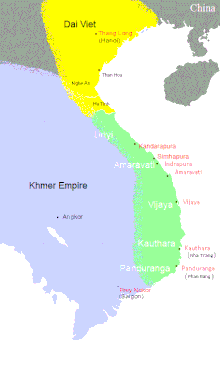
The central and southern part of present-day Vietnam were originally inhabited by theChamsand theKhmer people,respectively, who followed both a syncreticŚaiva-Mahayana(seeHistory of Buddhism in Cambodia).Theravādaspread from Sri Lanka to Cambodia during the 15th and 16th centuries, became established as the state religion in Cambodia and also spread to Cambodians living in theMekong Delta,replaced Mahayana.[59]Đại Việtannexed the land occupied by the Cham during conquests in the 15th century and by the 18th century had also annexed the southern portion of theKhmer Empire,resulting in the current borders of Vietnam. From that time onward, the dominant Đại Việt (Vietnamese) followed the Mahayana tradition while the Khmer people continued to practice Theravada Buddhism.[60]

In the 1920s and 1930s, there were a number of movements in Vietnam for the revival and modernization of Buddhist activities. Together with the re-organization of Mahayana establishments, there developed a growing interest in Theravadinmeditationas well as thePāli Canon.These were then available in French. Among the pioneers who brought Theravada Buddhism to the ethnic Đại Việt was a young veterinary doctor named Lê Văn Giảng. He was born in the Southern region, received higher education in Hanoi, and after graduation, was sent to Phnom Penh, Cambodia, to work for the French government.[61]
During that time, he became especially interested in Theravada Buddhist practice. Subsequently, he decided to ordain and took the Dhamma name of Hộ-Tông (Vansarakkhita). In 1940, upon an invitation from a group of lay Buddhists led by Nguyễn Văn Hiểu, he went back to Vietnam in order to help establish the first Theravadin temple for Vietnamese Buddhists at Gò Dưa, Thủ Đức (now a district of Hồ Chí Minh City). The temple was named Bửu Quang (Ratana Ramsyarama). The temple was destroyed by French troops in 1947, and was later rebuilt in 1951. At Bửu Quang temple, together with a group of Vietnamesebhikkhuswho had received training in Cambodia such as Thiện Luật, Bửu Chơn, Kim Quang and Giới Nghiêm, Hộ Tông began teaching Buddhism in their native Vietnamese. He also translated many Buddhist materials from thePali Canon,and Theravada Buddhism became part of Vietnamese Buddhist activity in the country.
In 1949–1950, Hộ Tông together with Nguyễn Văn Hiểu and supporters built a new temple in Saigon (now Hồ Chí Minh City), named Kỳ Viên Tự (Jetavana Vihara). This temple became the centre of Theravadin Buddhist activities in Vietnam, which continued to attract increasing interest among the Vietnamese Buddhists. In 1957, theVietnamese Theravada Buddhist Sangha Congregation(Giáo hội Tăng-già Nguyên thủy Việt Nam) was formally established and recognised by the government, and the Theravada Sangha elected Venerable Hộ Tông as its first President, orSangharaja.
From Saigon, the Theravadin Buddhist movement spread to other provinces, and soon, a number of Theravadin temples for ethnic Viet Buddhists were established in many areas in the Southern and Central parts of Vietnam. There are 529 Theravadin Buddhist temples throughout the country, of which 19 were located in Hồ Chí Minh City and its vicinity. Besides Bửu Quang and Kỳ Viên temples, other well known temples are Bửu Long, Giác Quang, Tam Bảo (Đà Nẵng), Thiền Lâm and Huyền Không (Huế), and the largeThích Ca Phật ĐàiinVũng Tàu.[62]
There is also a branch of Theravada Buddhism that also combines elements from the Mahayana tradition which is called Mendicant Buddhism or in Vietnamese,Đạo Phật Khất Sĩ Việt Nam,it was created by Thích Minh Đăng Quang, who wanted to create the original Buddhist tradition by walking barefoot and begging for alms.
Organizations
[edit]At the moment, theBuddhist Sangha of Vietnamis the official Buddhist organization of the whole Vietnam.[63]It was established on 7/11/1981, sponsored and recognized by theGovernment of Vietnam.[64]The headquarter is inHanoi.The current Supreme Patriarch is The Most VenerableThích Trí Quảng.
Another un-recognized Buddhist organization is theUnified Buddhist Church of Vietnamwhich has existed in the formerSouth VietnamduringVietnam War.[65]However many of its followers have joined the newly established Buddhist Sangha of Vietnam,[66]some followers resent the socialist government and oppose the new sangha.[67]Hence the Unified Buddhist Church still exists today in Vietnam (but very scattered and outlawed) and exile in overseas.
There are other smaller independent Buddhist sects exist in Vietnam such as:
- Dao Buu Son Ky Huong[68]
- Hoa Hao:under the Hoa Hao Buddhist Sangha[69][70]
- Minh Su Dao:influenced by Theravada Buddhism, Confucianism and Taoism; under the Theravada Buddhist Sangha of Minh Su Dao[71]
- Minh Ly Dao:influenced by Buddhism, Confucianism and Taoism[72]
- Tinh Do Cu Si Phat Hoi(Tinh do cu si Buddhism): under the Buddhist Sangha of Tinh Do Cu Si[73]
- Tu An Hieu Nghia Buddhism:under the Tu An Hieu Nghia Buddhist Association[74]
All of those Buddhist sects are recognized by the current Government of Vietnam.
Gallery
[edit]-
Bodhisattva on Lotus fresco figures, 10th - 13th century in Thien Ke Temple, Tuyen Quang
-
Buddhist Arhat mural in Liên Hoa cave, Ninh Bình province, dated 10-11th century
-
Buddhist Arhat mural in Liên Hoa cave, Ninh Bình province, dated 10-11th century
-
Idol and Painting in a temple of Gautama or Fo at Faifo by John Crawfurd book Published by H Colburn London 1828
-
Zen master Minh Hải
-
TheOne Pillar Pagodais a historic Mahayana Buddhist temple inHanoi,the capital of Vietnam.
-
Bái Đính Templeis a complex of Mahayana Buddhist temples on Bai Dinh Mountain.
-
Hải Đức Buddha, the 30 ft tall statue built in 1964 atLong Sơn TempleinNha Trang.
-
Ceramic pagoda with lotus, bodhi leaf, dancer decoration, Hanoi (Lý dynasty, 11th-13th century).
-
Terracotta Bodhi leaves with dragon motif (Lý-Trần dynasties, 11th-14th century).
See also
[edit]- Trúc Lâm
- Vietnamese Thiền
- Vô Ngôn Thông
- Thiền uyển tập anh
- Thích Ca Phật Đài
- Mahapanya Vidayalai
- Buddhist Sangha of Vietnam
- Vietnamese Buddhist Youth Association
- Unified Buddhist Sangha of Vietnam
- Buddhist temples in Huế
- Buddhist crisis
Notes
[edit]- ^Cuong Tu Nguyen & A.W. Barber. "Vietnamese Buddhism in North America: Tradition and Acculturation". in Charles S. Prebish andKenneth K. Tanaka(eds). The Faces of Buddhism in America. Berkeley: University of California Press, 1998, pg 130.
- ^"Buddhist Studies: Mahayana Buddhism: Vietnam".buddhanet.net.Retrieved2023-05-14.
- ^abcdPrebish, Charles. Tanaka, Kenneth.The Faces of Buddhism in America.1998. p. 134
- ^Cuong Tu Nguyen.Zen in Medieval Vietnam: A Study of the Thiền Uyển Tập Anh.Honolulu: University of Hawaii Press, 1997, pg 9.
- ^Cuong Tu Nguyen & A.W. Barber 1998, pg 132.
- ^Nguyen Tai Thu.The History of Buddhism in Vietnam.2008.
- ^Tai Thu Nguyen (2008).The History of Buddhism in Vietnam.CRVP. pp. 36–.ISBN978-1-56518-098-7.Archivedfrom the original on 2023-01-16.Retrieved2016-08-29.
- ^Tai Thu Nguyen (2008).The History of Buddhism in Vietnam.CRVP. pp. 36–.ISBN978-1-56518-098-7.Archived fromthe originalon 2015-01-31.Retrieved2017-12-04.
- ^Hall, Daniel George Edward (1981),History of South East Asia,Macmillan Education, Limited, pp. 201–202,ISBN978-1-349-16521-6
- ^Nguyen Tai Thu 2008, pg 77.
- ^Nguyen Tai Thu 2008, pg 75.
- ^Nguyen Tai Tu Nguyen 2008, pg 89.
- ^Việt Nam: Borderless Histories– Page 67 Nhung Tuyet Tran, Anthony Reid – 2006 "In this first formal attack in 1370, a Confucian official named Lê Quát attempted, without much success, to brand Buddhism as heretical and to promote Confucianism. Times had drastically changed by Ngô Sĩ Liên's Lê dynasty."
- ^The Vietnam Review:Volume 3 1997 "Buddhism The close association between kingship and Buddhism established by the Ly founder prevailed until the end of the Trân. That Buddhism was the people's predominant faith is seen in this complaint by the Confucian scholar Lê Quát."
- ^Elise Anne DeVido. "Buddhism for This World: The Buddhist Revival in Vietnam, 1920 to 1951, and Its Legacy." in Philip Taylor (ed),Modernity and Re-enchantment: Religion in Post-revolutionary Vietnam.Institute of Southeast Asian Studies: Singapore, 2007, p. 251.
- ^The 1966 Buddhist Crisis in South VietnamArchived2008-03-04 at theWayback MachineHistoryNet
- ^Gettleman, pp. 275–76, 366.
- ^Moyar, pp. 215–216.
- ^"South Viet Nam: The Religious Crisis".Time.1963-06-14. Archived fromthe originalon September 30, 2007.
- ^Tucker, pp. 49, 291, 293.
- ^Maclear, p. 63.
- ^"SNIE 53-2-63," The Situation in South Vietnam, 10 July 1963 ".Archived fromthe originalon April 1, 2010.
- ^Topmiller, p. 2.
- ^Karnow, pp. 295–325.
- ^Moyar, pp. 212–250.
- ^ab"Pure Land Buddhism recognised by Gov’t."Viet Nam News.December 27, 2007. Accessed: April 7, 2009.
- ^The Global Religious Landscape 2010Archived2013-07-19 at theWayback Machine.The Pew Forum.
- ^Home Office:Country Information and Guidance — Vietnam: Religious minority groupsArchived2015-05-18 at theWayback Machine.December 2014. Quoting United Nations'"Press Statement on the visit to the Socialist Republic of Viet Nam by the Special Rapporteur on freedom of religion or belief"Archived2017-10-10 at theWayback Machine.Hanoi, Viet Nam 31 July 2014.VietnameseArchived2017-10-10 at theWayback Machine.Quote, p. 8: "[...] According to the official statistics presented by the Government, the overall number of followers of recognized religions is about 24 million out of a population of almost 90 million. Formally recognized religious communities include 11 million Buddhists [...]"
- ^"Buddhist Studies Vietnam: Current and Future Directions | Kyoto Review of Southeast Asia".26 February 2016.Archivedfrom the original on 17 May 2020.Retrieved1 May2019.
- ^"Buddhism in Vietnam".2 October 2013.Archivedfrom the original on 23 December 2019.Retrieved1 May2019.
- ^"Inner Peace: Quotes from Zen Buddhist Master Thích Nhất Hạnh".Archivedfrom the original on 2019-12-22.Retrieved2019-05-01.
- ^"Comments on Tibet".27 March 2008.Archivedfrom the original on 1 May 2019.Retrieved1 May2019.
- ^"Phật giáo trong cộng đồng dân tộc thiểu số ở tỉnh Kon Tum hiện nay".phatgiao.org.vn(in Vietnamese). 2022-12-14.Retrieved2024-01-13.
- ^"Vài suy nghĩ về công tác hoằng pháp cho đồng bào dân tộc thiểu số tại Đắk Lắk trong bối cảnh mới".phatgiao.org.vn(in Vietnamese). 2022-12-01.Retrieved2024-01-13.
- ^Cuong Tu Nguyen & A. W. Barber 1998, p. 131.
- ^Elise Anne DeVido BuddhaDharma Magazine, May 2019
- ^abAlexander Soucy 2007.
- ^abCuong Tu Nguyen & A. W. Barber 1998, pg 135.
- ^abCuong Tu Nguyen & A. W. Barber 1998, pg 134.
- ^abcLê Tự Hỷ.
- ^abChandra 1988,p. 130-133.
- ^Kinh Dược Sư.Rộng Mở Tâm Hồn. pp. 9–11.Retrieved20 January2022.
- ^"Chú Đại Bi".chudaibi.vn.Archivedfrom the original on 19 November 2021.Retrieved20 January2022..
- ^Verses 25-26 form a single sentence.
- ^Verses 31-32 form a single sentence.
- ^Verses 34-40 form a single sentence.
- ^Verses 50-51 form a single sentence.
- ^Insanskritthe word used isSvāhā,translated byCon xin đón mừng Ngài(I welcome you) by vietnamese historien Lê Tự Hỷ (see details in section « References »).
- ^Verses 57-58 form a single sentence.
- ^Verses 78 and 79: These two verses are a repeat of verse 3, split into two parts.
- ^Verses 81-82-83: The four words (ten syllables) of these three verses constitute one sentence: «Án. Tất điện đô Mạn đá ra Bạt đà da(Om. May the wishes of this mantra come true». According to the Vietnamese Buddhist ritual, it must be repeated three times (as indicated in theKinh Dược Sư(Sutras Healers), and in the numbered version of the Chú Dai Bi.
- ^Chandra 1979,p. 13-14.
- ^Chandra 1988,p. 93-94.
- ^During the religious service, the vietnamesemonksandnuns(and thelay followersas well) recite the text divided into 84 verses (according to the Chinese version) and not the division of the Sanskrit text.
- ^Prebish, Charles. Tanaka, Kenneth.The Faces of Buddhism in America.1998. p. 135
- ^Cuong Tu Nguyen 1997, p. 94.
- ^Alexander Soucy. "Nationalism, Globalism and the Re-establishment of the Trúc Lâm Thien Sect in Northern Vietnam." in Philip Taylor (ed),Modernity and Re-enchantment: Religion in Post Revolutionary Vietnam.Institute of Southeast Asian Studies: Singapore, 2007; Cuong Tu Nguyen 1997, pg 342-3[1]Archived2023-01-16 at theWayback Machine
- ^Alexander Soucy 2007; Cuong Tu Nguyen & A. W. Barber 1998.
- ^Harris, Ian (2008).Cambodian Buddhism: History and Practice.University of Hawaii Press. pp. 35–36.
- ^Ven.Phra Palad Raphin Buddhisaro. (2017). Theravada Buddhism: Identity, Ethnic, Retention of “Khmer’s Krom” in Vietnam. Journal of Bodhi Research [Bodhi Vijjalai Collage] Srinakharinwiwot Universityhttp://gps.mcu.ac.th/wp-content/uploads/2013/02/11004-32450-1-SM-1.pdfArchived2020-07-11 at theWayback Machine
- ^Mae Chee Huynh Kim Lan.(2553/2010) A STUDY OF THERAVĀDA BUDDHISM IN VIETNAM.Thesis of Master of Arts (Buddhist Studies).Graduate School: Mahachulalongkornrajavidyalaya University.
- ^Lan, Ven. Huynh Kim.Theravāda Buddhism in Vietnam.10th National Conference on Buddhist Studies.
- ^"Đôi nét về đạo Phật và Giáo hội Phật giáo Việt Nam - Giới thiệu các tổ chức tôn giáo đã được công nhận | Ban Tôn giáo Chính Phủ".
- ^"Nhìn lại chặng đường 42 năm hình thành và phát triển Giáo hội Phật giáo Việt Nam".7 November 2023.
- ^"Những dấu ấn lịch sử Giáo hội Phật giáo Việt Nam".27 April 2015.
- ^"Những dấu ấn lịch sử Giáo hội Phật giáo Việt Nam".27 April 2015.
- ^"Lịch Sử Giáo Hội Phật Giáo Việt Nam Thống Nhất".
- ^"Giới thiệu khái quát về đạo Bửu sơn kỳ hương - Giới thiệu các tổ chức tôn giáo đã được công nhận | Ban Tôn giáo Chính Phủ".
- ^"Hệ thống tổ chức Giáo hội nhiệm kỳ III".
- ^"Đạo Phật giáo Hòa Hảo - Hoạt động và phát triển - Giới thiệu các tổ chức tôn giáo đã được công nhận | Ban Tôn giáo Chính Phủ".
- ^Phong, NGUYỄN THANH (2018),ĐẠO MINH SƯ TRONG ĐỜI SỐNG XÃ HỘI NAM BỘ NỬA CUỐI THẾ KỶ 19 ĐẾN NỬA ĐẦU THẾ KỶ 20.
- ^"Công nhận tổ chức tôn giáo Minh lý đạo – Tam tông miếu".17 October 2008.
- ^"Giới thiệu khái quát về Giáo hội Tịnh độ Cư sỹ Phật hội Việt Nam - Giới thiệu các tổ chức tôn giáo đã được công nhận | Ban Tôn giáo Chính Phủ".21 December 2021.
- ^"Đôi nét về đạo Tứ ân hiếu nghĩa - Giới thiệu các tổ chức tôn giáo đã được công nhận | Ban Tôn giáo Chính Phủ".
References
[edit]- Nguyen, Cuong Tu & A. W. Barber. "Vietnamese Buddhism in North America: Tradition and Acculturation". in Charles S. Prebish andKenneth K. Tanaka(eds)The Faces of Buddhism in America.Berkeley: University of California Press, 1998.
- Nguyen, Cuong Tu.Zen in Medieval Vietnam: A Study of the Thiền Uyển Tập Anh.Honolulu: University of Hawaii Press, 1997.
- Nguyễn Tài Thư (2008),History of Buddhism in Vietnam,Cultural heritage and contemporary change: South East Asia, CRVP,ISBN978-1565180987
- Soucy, Alexander. "Nationalism, Globalism and the Re-establishment of the Trúc Lâm Thien Sect in Northern Vietnam." Philip Taylor (ed).Modernity and Re-enchantment: Religion in Post-revolutionary Vietnam.Institute of Southeast Asian Studies: Singapore, 2007
- Ven.Phra Palad Raphin Buddhisaro. (2017). Theravada Buddhism: Identity, Ethnic, Retention of “Khmer’s Krom” in Vietnam. Journal of Bodhi Research [Bodhi Vijjalai Collage] Srinakharinwiwot Universityhttp://gps.mcu.ac.th/wp-content/uploads/2013/02/11004-32450-1-SM-1.pdf
- Ven.Phra Palad Raphin Buddhisaro. (2018). Annam Nikaya Buddhism on Vietnamese Style in Thailand: History and Development. International Conference, Thu Dau Mot University-Trường Đại Học Thủ Dầu Một Thu Dau Mot City, Binh Duong Province, Vietnam. 7–8 December 2561http://gps.mcu.ac.th/wp-content/uploads/2016/09/Paper_Annam-Chaiyaphum-Journal.pdf
- Mae Chee Huynh Kim Lan.(2553/2010) A STUDY OF THERAVĀDA BUDDHISM IN VIETNAM.Thesis of Master of Arts (Buddhist Studies).Graduate School: Mahachulalongkornrajavidyalaya University.
References related to the Chú Đại Bi
- Kinh Dược Sư.Rộng Mở Tâm Hồn. pp. 9–11.Retrieved22 January2022.
- "Chú Đại Bi".chudaibi.vn.Retrieved22 January2022.
- Chandra, Lokesh (1979)."Origin of the Avalokiteśvara of Potala"(PDF).Kailash: A Journal of Himalayan Studies.7(1). Ratna Pustak Bhandar: 6–25.Retrieved22 January2022.
- Chandra, Lokesh (1988).The Thousand-armed Avalokiteśvara.New Delhi: Abhinav Publications, Indira Gandhi National Centre for the Arts.ISBN81-7017-247-0.Retrieved22 January2022.
- "Lê Tự Hỷ:" Chú Đại Bi: Về Bản Phạn Văn Và Ý Nghĩa Của Chú Đại Bi "(Chú Đại Bi: about the meaning of mantra in Sanskrit)".tamduc.net.vn.2013. Archived fromthe originalon 22 January 2022.Retrieved22 January2022.
Further reading
[edit]- DeVido, Elise A. (2009).The Influence of Chinese Master Taixu on Buddhism in VietnamArchived2022-02-03 at theWayback Machine,Journal of Global Buddhism 10, 413–458
- Buswell, Robert E., ed. (2004)."Vietnam", in Encyclopedia of Buddhism.Macmillan Reference USA. pp. 879–883.ISBN0-02-865718-7.
External links
[edit] Media related toBuddhism in Vietnamat Wikimedia Commons
Media related toBuddhism in Vietnamat Wikimedia Commons- Phật Học Online
- phattuvn.org





